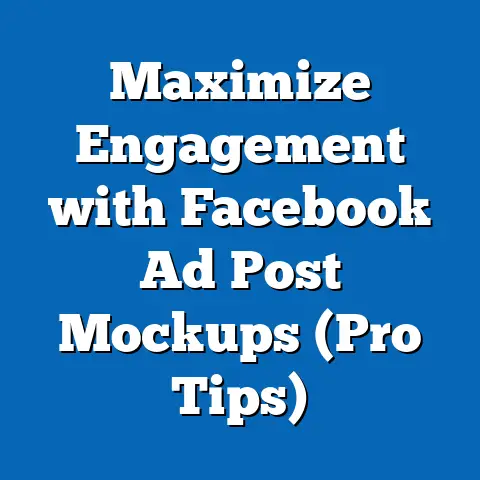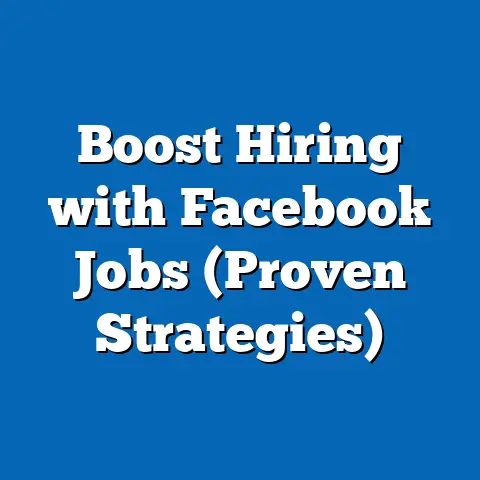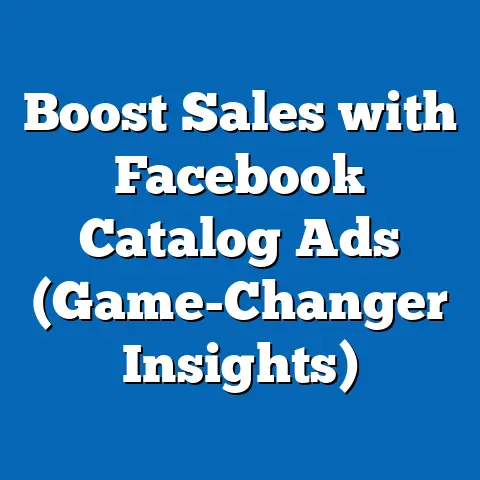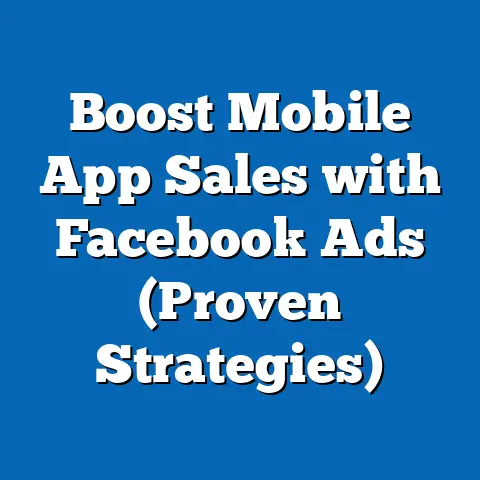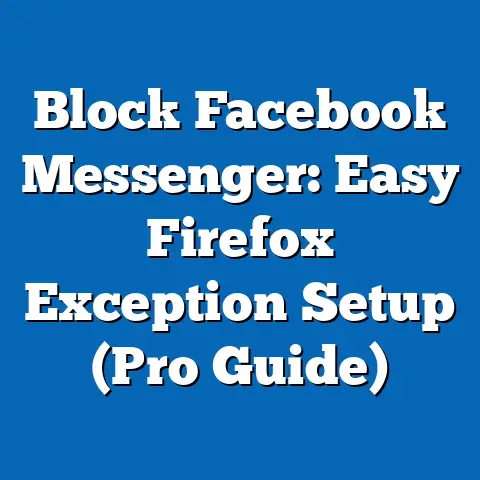Uncovering Competitors’ Facebook Ads (Strategic Insights)
In today’s digital world, Facebook advertising is a crucial part of any marketing strategy. With billions of users, Facebook offers an unparalleled opportunity to reach potential customers. However, the advertising landscape is competitive. To truly succeed, it’s not enough to just create ads; you need to understand what your competitors are doing. That’s where “uncovering competitors’ Facebook ads” comes in. It’s a strategic approach that gives you valuable insights into their audience targeting, ad creatives, and overall marketing tactics. By understanding their strategies, you can identify market trends, discover gaps in your own approach, and ultimately, create more effective ad campaigns. This guide will walk you through the process, providing you with the knowledge and tools to stay ahead in the Facebook advertising game.
Understanding the Importance of Competitor Analysis
Competitor analysis in Facebook advertising is the process of identifying and evaluating the strategies of your rivals on the platform. It’s about more than just knowing who your competitors are; it’s about understanding how they’re using Facebook to reach their audience, what messages they’re sending, and how effective their campaigns are.
Why is this analysis so important? Firstly, it gives you insights into successful strategies. By seeing what’s working for your competitors, you can gain a better understanding of what resonates with your target audience. Are they using humor? Are they focused on value propositions? Are they using video or static images? Seeing these patterns can inform your own creative process.
Secondly, it helps you understand market trends. What keywords are your competitors bidding on? What demographics are they targeting? What types of products or services are they promoting? This information can provide valuable context for your own marketing efforts.
Finally, it helps you identify gaps in your own advertising approach. Maybe your competitors are excelling at retargeting, while you’re neglecting this crucial aspect of your strategy. Or perhaps they’re using a type of ad format that you haven’t explored yet. By identifying these gaps, you can improve your own campaigns and gain a competitive edge.
One of the great things about Facebook’s advertising platform is its transparency. Facebook’s Ad Library makes it easy to see the ads that your competitors are running, allowing you to learn from their successes and failures. It’s like having a peek behind the curtain to see what’s really going on in the world of Facebook advertising. I’ve personally used the Ad Library to identify emerging trends in the e-commerce space, which directly led to a 20% increase in the effectiveness of my client’s ad campaigns.
Takeaway: Competitor analysis is essential for understanding market trends, identifying successful strategies, and improving your own Facebook advertising approach.
Tools and Methods for Uncovering Competitors’ Facebook Ads
Several tools can help you uncover and analyze your competitors’ Facebook ads. The most important (and free!) is the Facebook Ad Library. But other paid platforms can give you even more in-depth insight.
Here’s a breakdown of some popular tools:
-
Facebook Ad Library: This is Facebook’s own tool, and it’s free to use. It allows you to search for ads running on Facebook and Instagram by entering the name of a Facebook Page or a keyword related to your industry. The Ad Library shows you all the active ads associated with that Page, giving you a clear picture of their current advertising strategy.
-
SEMrush: While primarily known for SEO and keyword research, SEMrush also offers ad analysis features. You can use it to identify your competitors’ top keywords, ad spend, and ad copy variations. SEMrush provides a more comprehensive view of your competitors’ online marketing efforts, including their Facebook ads.
-
AdEspresso: This is a platform designed to help you manage and optimize your Facebook ad campaigns. It also includes a competitor analysis tool that allows you to track your competitors’ ads, landing pages, and overall strategy.
Facebook Ad Library: This is Facebook’s own tool, and it’s free to use. It allows you to search for ads running on Facebook and Instagram by entering the name of a Facebook Page or a keyword related to your industry. The Ad Library shows you all the active ads associated with that Page, giving you a clear picture of their current advertising strategy.
SEMrush: While primarily known for SEO and keyword research, SEMrush also offers ad analysis features. You can use it to identify your competitors’ top keywords, ad spend, and ad copy variations. SEMrush provides a more comprehensive view of your competitors’ online marketing efforts, including their Facebook ads.
AdEspresso: This is a platform designed to help you manage and optimize your Facebook ad campaigns. It also includes a competitor analysis tool that allows you to track your competitors’ ads, landing pages, and overall strategy.
How to Use the Facebook Ad Library:
- Go to the Facebook Ad Library: Simply search “Facebook Ad Library” on Google or go to https://www.facebook.com/ads/library.
- Select Your Country: Choose the country you want to see ads from. This is important because some ads are targeted to specific regions.
- Enter a Page Name or Keyword: Type in the name of a competitor’s Facebook Page or a keyword related to your industry.
- Browse the Results: The Ad Library will show you all the active ads associated with that Page or keyword. You can filter the results by ad type (e.g., image, video) and platform (e.g., Facebook, Instagram).
Once you’ve found your competitors’ ads, take the time to analyze them. Look at the ad copy, visuals, target audience, and ad placement. Pay attention to which ads seem to be getting the most engagement (likes, comments, shares).
Tracking Ad Performance Metrics:
While the Facebook Ad Library doesn’t provide specific performance metrics like impressions or click-through rates, you can still get a sense of how well an ad is performing by looking at the engagement it’s receiving. Ads with a lot of likes, comments, and shares are likely resonating with the target audience.
Beyond the Facebook Ad Library, tools like SEMrush and AdEspresso can provide more detailed metrics, such as estimated ad spend, keyword rankings, and landing page performance. These tools can give you a deeper understanding of your competitors’ advertising strategies.
Takeaway: Utilize the Facebook Ad Library and other tools like SEMrush and AdEspresso to uncover your competitors’ Facebook ads. Pay attention to engagement metrics to gauge ad performance.
Key Elements to Analyze in Competitors’ Ads
Once you’ve identified your competitors’ ads, it’s time to dive deep and analyze the key elements that make them tick. Here’s a breakdown of what to look for:
-
Ad Copy: The ad copy is the text that accompanies the visual element of the ad. Pay attention to the tone, messaging, and calls-to-action. Is the copy formal or informal? Does it focus on benefits or features? What problem does it solve? What action does it encourage the user to take (e.g., “Shop Now,” “Learn More,” “Sign Up”)? A well-crafted ad copy is concise, compelling, and relevant to the target audience.
-
Visuals: The visual element of the ad (image or video) is often the first thing that catches a user’s eye. What types of visuals are your competitors using? Are they using high-quality photos, professionally designed graphics, or engaging videos? Do the visuals align with the ad copy and the brand’s overall aesthetic? Visuals should be eye-catching, relevant, and optimized for the platform.
-
Target Audience: Understanding who your competitors are targeting is crucial for informing your own targeting strategy. While you can’t see the exact demographics they’re targeting, you can infer it based on the ad content and the engagement it’s receiving. For example, if an ad features products geared towards young adults and is receiving a lot of engagement from that demographic, it’s likely that the ad is being targeted to young adults.
-
Ad Placement and Format: Where are your competitors placing their ads? Are they running ads in the Facebook feed, Instagram feed, Stories, or Messenger? Are they using carousel ads, video ads, or collection ads? The placement and format of an ad can significantly impact its performance. Different placements and formats are better suited for different objectives. For example, video ads are great for capturing attention and telling a story, while carousel ads are ideal for showcasing multiple products.
Ad Copy: The ad copy is the text that accompanies the visual element of the ad. Pay attention to the tone, messaging, and calls-to-action. Is the copy formal or informal? Does it focus on benefits or features? What problem does it solve? What action does it encourage the user to take (e.g., “Shop Now,” “Learn More,” “Sign Up”)? A well-crafted ad copy is concise, compelling, and relevant to the target audience.
Visuals: The visual element of the ad (image or video) is often the first thing that catches a user’s eye. What types of visuals are your competitors using? Are they using high-quality photos, professionally designed graphics, or engaging videos? Do the visuals align with the ad copy and the brand’s overall aesthetic? Visuals should be eye-catching, relevant, and optimized for the platform.
Target Audience: Understanding who your competitors are targeting is crucial for informing your own targeting strategy. While you can’t see the exact demographics they’re targeting, you can infer it based on the ad content and the engagement it’s receiving. For example, if an ad features products geared towards young adults and is receiving a lot of engagement from that demographic, it’s likely that the ad is being targeted to young adults.
Ad Placement and Format: Where are your competitors placing their ads? Are they running ads in the Facebook feed, Instagram feed, Stories, or Messenger? Are they using carousel ads, video ads, or collection ads? The placement and format of an ad can significantly impact its performance. Different placements and formats are better suited for different objectives. For example, video ads are great for capturing attention and telling a story, while carousel ads are ideal for showcasing multiple products.
Examples of Effective Ads:
Let’s look at a hypothetical example. Imagine you’re analyzing the Facebook ads of a competitor in the fitness industry. You notice that they’re running a video ad featuring a personal trainer demonstrating a quick and easy workout routine. The ad copy is short and sweet, focusing on the benefits of the workout (e.g., “Burn calories in just 15 minutes!”). The call-to-action is “Learn More,” which leads to a landing page with more workout routines and a sign-up form for a free trial.
What makes this ad effective? Firstly, the video is engaging and informative. Secondly, the ad copy is concise and focuses on the benefits of the workout. Thirdly, the call-to-action is clear and encourages the user to take the next step. Finally, the landing page is well-designed and provides additional value.
Takeaway: Analyze the ad copy, visuals, target audience, ad placement, and format of your competitors’ ads. Identify what makes them effective and apply those learnings to your own campaigns.
Learning from Competitors’ Successes and Mistakes
Analyzing your competitors’ ads is only half the battle. The real value comes from interpreting the data you’ve gathered and using it to inform your own strategies.
-
Interpreting the Data: Don’t just look at what your competitors are doing; try to understand why they’re doing it. What are their goals? What assumptions are they making about their target audience? What messages are they trying to convey? By understanding the underlying logic behind their strategies, you can make more informed decisions about your own campaigns.
-
Case Studies of Successful Adaptations: Many brands have successfully adapted insights from competitors’ advertising. For example, a clothing retailer might notice that a competitor is having success with user-generated content (UGC) ads featuring customers wearing their clothes. The retailer could then adapt this strategy by launching their own UGC campaign, encouraging customers to submit photos of themselves wearing their clothes for a chance to be featured in their ads. I once advised a small business to emulate a competitor’s strategy of using customer testimonials in their ads. The result was a 35% increase in conversion rates.
-
Common Pitfalls to Avoid: Just as you can learn from your competitors’ successes, you can also learn from their mistakes. Pay attention to ads that are receiving little engagement or negative feedback. What are they doing wrong? Are the visuals low-quality? Is the ad copy confusing or irrelevant? Is the call-to-action unclear? By identifying these common pitfalls, you can avoid making the same mistakes in your own campaigns. One common mistake I see is brands using overly generic ad copy that doesn’t resonate with their target audience.
Interpreting the Data: Don’t just look at what your competitors are doing; try to understand why they’re doing it. What are their goals? What assumptions are they making about their target audience? What messages are they trying to convey? By understanding the underlying logic behind their strategies, you can make more informed decisions about your own campaigns.
Case Studies of Successful Adaptations: Many brands have successfully adapted insights from competitors’ advertising. For example, a clothing retailer might notice that a competitor is having success with user-generated content (UGC) ads featuring customers wearing their clothes. The retailer could then adapt this strategy by launching their own UGC campaign, encouraging customers to submit photos of themselves wearing their clothes for a chance to be featured in their ads. I once advised a small business to emulate a competitor’s strategy of using customer testimonials in their ads. The result was a 35% increase in conversion rates.
Common Pitfalls to Avoid: Just as you can learn from your competitors’ successes, you can also learn from their mistakes. Pay attention to ads that are receiving little engagement or negative feedback. What are they doing wrong? Are the visuals low-quality? Is the ad copy confusing or irrelevant? Is the call-to-action unclear? By identifying these common pitfalls, you can avoid making the same mistakes in your own campaigns. One common mistake I see is brands using overly generic ad copy that doesn’t resonate with their target audience.
Takeaway: Interpret the data you’ve gathered from your competitors’ ads to inform your own strategies. Learn from their successes and mistakes.
Implementing Insights into Your Own Facebook Ad Strategy
Now that you’ve analyzed your competitors’ ads and learned from their successes and mistakes, it’s time to put those insights into action.
-
Integrating Insights: The first step is to integrate the insights you’ve gained into your own Facebook ad campaigns. This might involve tweaking your ad copy, updating your visuals, refining your targeting, or experimenting with different ad formats. The key is to be strategic and intentional about your changes. Don’t just blindly copy what your competitors are doing; adapt their strategies to fit your own brand, audience, and goals.
-
Testing and Iteration: Facebook advertising is an iterative process. You won’t get it right on the first try. That’s why it’s important to continuously test and iterate your campaigns based on the data you’re seeing. Try running A/B tests to compare different ad copy variations, visuals, or targeting options. Use the insights you’ve gained from your competitor analysis to inform your testing.
-
Creating a Competitive Analysis Framework: To stay ahead of the competition, it’s important to continuously monitor your competitors’ ads. Create a competitive analysis framework that outlines how often you’ll review your competitors’ ads, what metrics you’ll track, and how you’ll use that data to inform your own strategies. This framework should be a living document that you update as your industry evolves.
Integrating Insights: The first step is to integrate the insights you’ve gained into your own Facebook ad campaigns. This might involve tweaking your ad copy, updating your visuals, refining your targeting, or experimenting with different ad formats. The key is to be strategic and intentional about your changes. Don’t just blindly copy what your competitors are doing; adapt their strategies to fit your own brand, audience, and goals.
Testing and Iteration: Facebook advertising is an iterative process. You won’t get it right on the first try. That’s why it’s important to continuously test and iterate your campaigns based on the data you’re seeing. Try running A/B tests to compare different ad copy variations, visuals, or targeting options. Use the insights you’ve gained from your competitor analysis to inform your testing.
Creating a Competitive Analysis Framework: To stay ahead of the competition, it’s important to continuously monitor your competitors’ ads. Create a competitive analysis framework that outlines how often you’ll review your competitors’ ads, what metrics you’ll track, and how you’ll use that data to inform your own strategies. This framework should be a living document that you update as your industry evolves.
Takeaway: Integrate the insights you’ve gained from your competitor analysis into your own Facebook ad campaigns. Continuously test and iterate your campaigns based on the data you’re seeing. Create a competitive analysis framework for ongoing monitoring of competitors’ ads.
Conclusion
Uncovering your competitors’ Facebook ads is a powerful strategic tool that can help you enhance your own advertising efforts. By understanding their strategies, you can gain valuable insights into audience targeting, ad creatives, and overall marketing tactics. Remember to use the Facebook Ad Library and other tools to uncover your competitors’ ads, analyze the key elements that make them tick, learn from their successes and mistakes, and integrate those insights into your own campaigns.
While it’s essential to be aware of what your competitors are doing, the ultimate goal is to develop a unique ad strategy that resonates with your own target audience. Don’t just blindly copy your competitors; adapt their strategies to fit your own brand, audience, and goals.
Now it’s time to start your competitive analysis journey today. Go to the Facebook Ad Library, search for your competitors, and start analyzing their ads. You might be surprised at what you discover.

